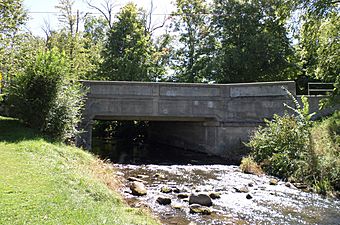Ash Street-Sycamore Creek Bridge facts for kids
Quick facts for kids |
|
|
Ash Street-Sycamore Creek Bridge
|
|
 |
|
| Location | MI-36 over Sycamore Cr., Mason, Michigan |
|---|---|
| Area | less than one acre |
| Built | 1918 |
| Built by | J. Morehouse |
| Architect | W.E. Zimmer |
| Architectural style | T-Beam |
| MPS | Highway Bridges of Michigan MPS |
| NRHP reference No. | 99001673 |
| Added to NRHP | January 14, 2000 |
The Ash Street-Sycamore Creek Bridge is a special old bridge in Mason, Michigan. It crosses over Sycamore Creek on Ash Street, which is also known as MI-36. This bridge was added to the National Register of Historic Places in 1999 because it's an important part of history. It's also one of the oldest bridges of its kind in Michigan!
Contents
Building the Ash Street Bridge
When Was the Bridge Built?
The Ash Street bridge was built a long time ago, in 1918. The city of Mason worked to get it constructed.
Who Designed and Built It?
A person named W.E. Zimmer designed the bridge. He created a special plan that was different from other bridges built by the state at that time. The actual construction was done by a builder named J. Morehouse.
How Is It Used Today?
After it was built, the bridge eventually became part of the state's road system. As of 2010, the bridge was still being used every day. It was also in very good condition, showing how well it was made!
What Does the Ash Street Bridge Look Like?
Understanding a T-Beam Bridge
The Ash Street bridge is a concrete T-beam bridge. Imagine a "T" shape; this design helps make the bridge very strong. It's made from concrete, which is a very durable material.
Key Features of the Bridge
The bridge stretches 29 feet across Sycamore Creek. It has a wide top part, called the deck, which is about 56.6 feet wide. The part where cars drive is 36 feet wide.
Safety and Design Details
Along the sides of the roadway, there are strong concrete railings. These railings have four special panels that are set back a little. There are also sidewalks on both sides of the bridge, inside the railings, for people to walk safely. The bottom parts of the bridge, called abutments, are straight concrete walls. You can even find information about when the bridge was built etched into the concrete on the north railing!

